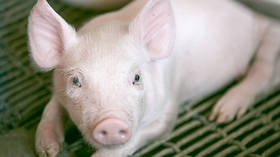Dead pigs’ organs partially revived – study

Scientists managed to revive cells and restore some organ function in pigs that had been dead for more than an hour in a groundbreaking experiment which raises the question about where the line between life and death lies.
In a report published in Nature magazine on Wednesday, a group of Yale scientists revealed that they restored blood circulation and cellular activity in such pig organs as heart and brain by pumping a custom-made solution into the dead animals.
The procedure, called OrganEx, saw the bodies injected with a fluid that contained pig blood and 13 other compounds such as anticoagulants. The solution, according to the scientists, “slowed the decomposition of the bodies and quickly restored some organ function,” making pig hearts contract again, with liver and kidneys demonstrating some activity.
The dead pigs started some involuntarily body movements, jerking their head, neck and torso after being injected with contrast dye that was meant to help scientists monitor brain activity. The researchers could not say why exactly this happened, but suggested that the movements arose not in the brain, but in the spinal cord which may control some motor functions.
At the same time, while the system managed to defend some brain tissue from damage, there were no signs that the animals had regained any consciousness.
Nonetheless, Nita Farahany, a neuroethicist at Duke University in Durham, North Carolina, told the magazine that these latest experiments were “stunning.” While she cautioned that this study is preliminary, she said it supports the idea that some perceived limitations of the human body might be overcome in time.
According to Dr. Sam Parnia, an associate professor of critical care medicine and director of critical care and resuscitation research at NYU Grossman School of Medicine, this study is “truly remarkable” and “incredibly significant.” “It demonstrates that after death, cells in mammalian organs (including humans) such as the brain do not die for many hours,” he told Science Media Centre.
He also highlighted that the research might contribute to blurring the boundaries between life and death, saying that the study demonstrated that “our social convention regarding death… as an absolute black and white end is not scientifically valid.” “By contrast, scientifically, death is a biological process that remains treatable and reversible for hours after it has occurred,” he added.
The researchers believe that their findings may be ultimately applied to humans. According to Farahany, the implications may be as “profound” as the advent of CPR and ventilators, because the new method could potentially be used to save organs for transplantation or even resuscitate them.
The experiment follows a 2019 study that saw scientists successfully restoring cellular function in a number of pig brains that had been dead for several hours. In addition to questioning the definition of death, the research also provided scientists with a valuable platform for studying brain disorders and diseases.













